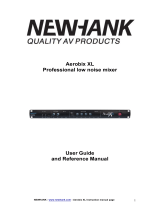
Electro-Voice
®®
®®
®
Rear Panel Controls and Connections (cont)
13. Terminals for the DC battery supply: These two terminals allow
the connection of an external 24V DC power supply such as a
24V battery. Operation of the amplifier is maintained even during
a power outage, since it is automatically switched to the DC
power source.
14. Output terminals: All speaker connections are made here. 25v/
70v/100v and low impedance speaker connections are sup-
ported. For additional information on constant voltage and low
impedance speaker hookups see section 4 Output Connec-
tions.
15. PRE OUT terminal: This terminal output provides the mixed
audio signals of all sources that are connected to the amplifier
and can be utilized to feed an external power amplifier, a signal
processor or any other external appliance. The unbalanced signal
is affected by the individual input controls. Before using the PRE
OUT you have to remove the bridging-strip between this binding
post and the MAIN IN terminal (16).
16. MAIN IN terminal: After removing bridging-strip between the
PRE OUT and the MAIN IN terminals you can include an
external signal processor in the audio-chain between the pre-
amplifier and the power output stage of the power amplifier.
17. AUX 1 and AUX 2 inputs: These two RCA-type connectors let
you connect the two channels of an external high-level unbal-
anced signal source. Such as an AM/FM tuner, a cassette deck,
a CD player, etc.. An input level switch(20) is provided to properly
balance the input sensitivity with a variety of sources.
18. INPUT 1- 10 jacks: These ten balanced/unbalanced combination
type jack (XLR and 6.3mm) inputs are meant for the connection
of-condenser type microphones that accepts 24V phantom
power, dynamic microphones (30-600ohms) or a high level sound
sources (e.g AM/FM tuner, cassette deck, CD player, etc.)
Note: Connecting unbalanced microphones to the appliance when the
phantom is switched on could lead to severe damage to the
microphones and is therefore not advisable. It is absolutely
mandatory to only plug or unplug a microphone cable with the
phantom power turned off. Also make sure that the phantom
power is turned off when utilizing microphones that are not meant
to be operated with phantom power. The voltage that is present
on pin2 and pin3 of the XLR-connector could lead to severe
damage to the microphones. When in doubt, contact your dealer
before you perform any connections.
Page 10






















